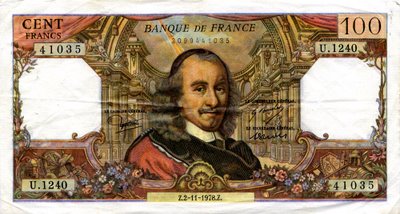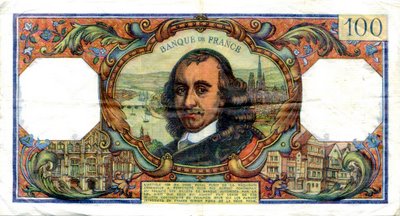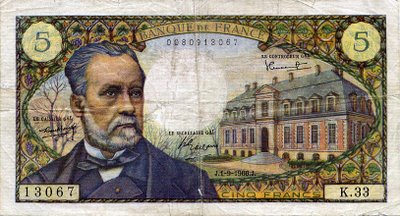 This a 100-franc note from the 1970s. I found it tucked in with
This a 100-franc note from the 1970s. I found it tucked in withsome old photos I was sorting through this morning.
The man on the bill is the classical playwright Pierre Corneille.
More importantly, France, Spain, Italy, Belgium, the Netherlands, and Germany, to name just some of the euro countries, now all use the same currency. It's no longer necessary to change money when you go from one of these countries to another. And you can easily compare prices from country to country. That's progress, I think.
My first trip to France was in 1970, when I was 20 years old. For 32 years, the franc was the official currency, and I was comfortable with its value, its denominations, the look of its bills and coins. In general, the franc was worth about $0.20. In other words, $1.00 was worth 5 FF (five francs).
 Here is the flip side of the same 100-franc note. I remember that in the '90s
Here is the flip side of the same 100-franc note. I remember that in the '90sI tried to use it to pay for drinks in a Paris café one day. The waiter said
it was no longer legal tender, but he was very interested in examining it.
He called it a « monument historique ». Corneille was from Rouen, where I
worked for a year in the early '70s, and that's Rouen's cathedral on the bill.
That value fluctuated over the years. I remember that in 1970 the dollar was worth 5.6 FF. And in the late 1970s there was a time when it was worth only four francs. In the 1980, when France elected Socialist François Mitterrand president and the U.S. elected pro-business Republican Ronald Reagan, the franc crashed and the dollar soared. $1.00 was worth ten francs for a while there. Americans in France were flying high.
 This five-franc note was the equivalent of a dollar bill when I was a student
This five-franc note was the equivalent of a dollar bill when I was a studentin Aix-en-Provence in 1970. I saved one as a souvenir. The five-franc note
was taken out of circulation in the 1970s and replaced by a five-franc coin.
Officially, 1€ (one euro) is worth about 6.5 francs. And right now one euro is worth about $1.30. That seems like a pretty bad exchange rate for Americans.
In fact, the U.S. dollar has declined in value by nearly 50% since the euro was first introduced in 2002 — back then you could buy a euro for about $0.85. The adoption of the euro was a grand experiment, and the value of European currencies against the dollar stayed low for a while as the market surveyed the situation.
So where do we stand today? Even with the euro at $1.30, the dollar is still worth just about five French francs. Do the math: divide 6.50 by 1.30. So we are still where we were back in the 1970s as far as the relative value of the French and U.S. currencies go.
Still, I miss the franc in a way. The bills were so colorful and detailed. The euro notes are very plain in comparison.


I always loved the French francs. When I lived in Paris in the '60s, France was converting old francs into new francs. So, it was common, especially in the markets, to hear people quoting you a price in old francs, for example, mille francs which meant dix francs in new francs. It became most confusing; the older people refused to speak in new francs. Gabby
ReplyDeleteHi Gabby, the first time I came to France was in 1970. Then and all through the '70s, people talked in old francs. I became pretty proficient at it. Mille balles was 10FF, and dix mille balles was 100FF. Un million was ten thousand FF, or about $2,000. Toward 1980, people had started using the term centimes to distinquish old francs from new francs, so $2,000 was worth either dix mille francs or un million de centimes.
ReplyDeleteToday all prices are displayed in euros and in francs, by law. People who aren't yet comfortable with the euro can see the price in a familiar currency. I think the double-pricing rule is to last until 2010.